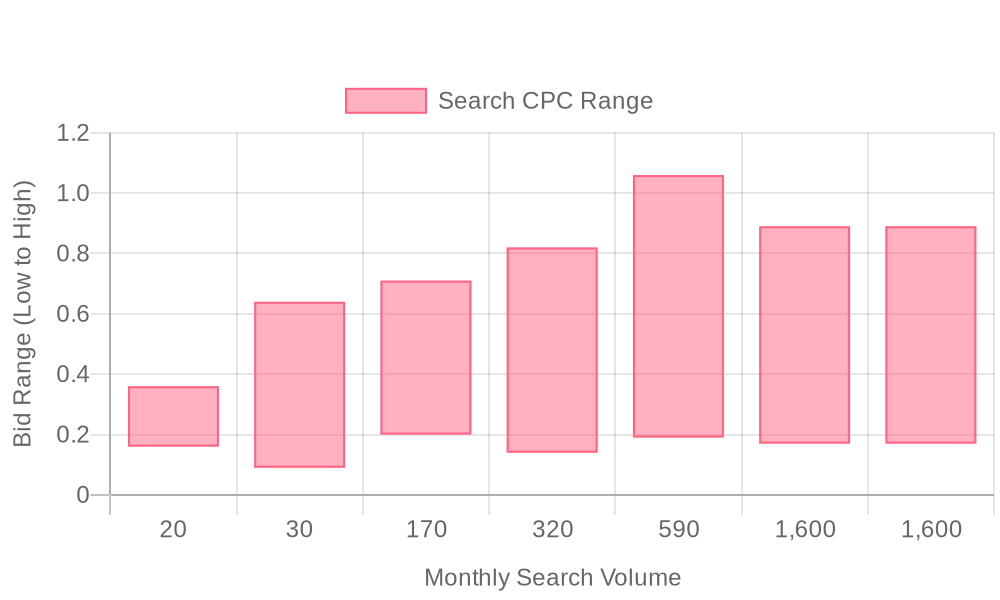
Supercharge your lead generation with a FREE Google Ads audit - no strings attached! See how you can generate more and higher quality leads
Get My Free Google Ads AuditFree consultation

No commitment
Supercharge your lead generation with a FREE LinkedIn Ads audit - no strings attached! See how you can generate more and higher quality leads
Get My Free Google Ads AuditFree consultation

No commitment
Supercharge your lead generation with a FREE Meta Ads audit - no strings attached! See how you can generate more and higher quality leads
Get My Free Google Ads AuditGet My Free LinkedIn Ads AuditGet My Free Meta Ads AuditFree consultation

No commitment
Supercharge your lead generation with a FREE Google Ads audit - no strings attached! See how you can generate more and higher quality leads
Get My Free Google Ads AuditFree consultation

No commitment
In today's complex marketing landscape, effective B2B marketing requires a strategic mix of both online and offline channels working in concert. Online channels like social media build digital brand awareness, email marketing nurtures ongoing relationships, and SEO drives organic visibility. Meanwhile, offline channels such as trade shows generate face-to-face connections, direct mail creates tangible touchpoints, and industry publications establish thought leadership. Within this integrated ecosystem, Google Ads plays a critical middle-funnel role by capturing high-intent prospects at the exact moment they’re searching for solutions—effectively bridging the gap between broader awareness efforts and your sales process.

Automotive grille manufacturers and distributors face uniquely complex buyer journeys driven by high-consideration purchases and varying technical requirements. Maximizing lead generation requires a data-driven, integrated approach that captures in-market demand and aligns marketing messages with each decision-maker’s intent signals.
This playbook is designed for B2B revenue teams seeking to unify their paid search with broader digital marketing strategies. It provides a framework to not only drive qualified leads through Google Ads for Automotive Grilles but also to measure and optimize every touchpoint—online and offline—for true ROI clarity.
By leveraging this structured, data-first methodology, revenue teams position themselves to capture the most valuable leads, maximize campaign efficiency, and deliver measurable business growth in the competitive automotive grilles market. Get started for free with Sona.
Automotive grille manufacturers and distributors face a unique set of challenges in the digital landscape. The search-driven nature of Google Ads provides a direct path to reach specialized audiences who are actively seeking grille solutions, ensuring marketing investments deliver measurable returns. For a comprehensive overview of Google Ads best practices tailored to the auto industry, refer to this automotive ads guide, and discover more insights in our marketing analytics blog.

Automotive grille marketers striving for scalable growth must look beyond traditional channels and seize untapped demand. By identifying and targeting vertical keywords that align with your specialty—such as custom grilles, OEM replacements, or aftermarket performance upgrades—you position your campaigns to capture precise intent that broader content strategies often overlook. Discover more about real-time audience segmentation to refine your vertical keyword strategy and reach buyers at the right stage.
Unifying all these tactics addresses fragmented customer journeys by ensuring consistent presence and message reinforcement across every relevant touchpoint. When enhanced with real-time data—such as identifying which companies engage with your content or tracking dynamic intent signals—you unlock the ability to allocate budget toward audiences most likely to convert. This transforms typical automotive digital marketing from broad reach to precision engagement, ultimately maximizing both visibility and marketing ROI. To see how these strategies can work for you, get started for free with Sona.

Data-driven segmentation is fundamental for maximizing returns in automotive digital marketing. By mapping your audience with precise audience intelligence, every dollar invested in Google Ads for Automotive Grilles delivers greater relevance and higher conversion rates. For deeper marketing insights, explore our marketing analytics blog.
Ready to elevate your automotive grille campaigns? Get started for free with Sona.

| Industry | Keyword | Monthly Search Volume | Competition Level | Low Bid | High Bid |
| Automotive Grilles | 2020 ford edge black grill | 20 | HIGH | 0.16 | 0.36 |
| Automotive Grilles | aftermarket car grill | 30 | MEDIUM | 0.09 | 0.64 |
| Automotive Grilles | car grill accessories | 170 | HIGH | 0.2 | 0.71 |
| Automotive Grilles | aftermarket auto grills | 320 | HIGH | 0.14 | 0.82 |
| Automotive Grilles | automotive grilles | 590 | HIGH | 0.19 | 1.06 |
| Automotive Grilles | car grill mesh | 1600 | HIGH | 0.17 | 0.89 |
| Automotive Grilles | automotive grill mesh | 1600 | HIGH | 0.17 | 0.89 |
Automotive digital marketing teams thrive on precise targeting and data-driven execution. Selecting the right keywords positions your brand in front of buyers who are actively evaluating grilles for their vehicles, not just passively browsing. This targeted approach ensures your message reaches in-market prospects at the moment of highest intent, accelerating deal velocity and maximizing marketing efficiency with the help of real-time audience segmentation.
A well-structured keyword strategy for automotive grilles focuses on capturing both broad and highly specific searches. For example, terms like "custom auto grills," "high-performance vehicle grilles," and "chrome car grilles" target buyers at various stages of their journey. Early-stage keywords attract those exploring upgrades, while branded or product-specific terms capture late-stage shoppers ready to request quotes or make purchases—insights you can amplify using intent signals to prioritize high-value prospects.
Automotive advertising success hinges on matching keyword strategy to real buyer behavior. By mapping "Google Ads for Automotive Grilles" and related search terms to each stage of your funnel, you build a foundation for scalable, high-performing campaigns that drive real business outcomes. For further insight into optimizing these efforts, explore this comprehensive guide to creating effective automotive ads on Google. If you’re ready to turn keyword data into action, get started for free with Sona.
A robust campaign execution framework is essential for revenue teams targeting the automotive grilles market. By combining precise keyword targeting, compelling creative, and unified data, organizations can consistently drive qualified leads and outperform standard benchmarks. The following framework lays out the exact steps to maximize your results and ROI in Google Ads for Automotive Grilles while ensuring every touchpoint is measurable and actionable.
Building segmented keyword lists for automotive grilles campaigns requires a granular approach. Cluster keywords by grille type—chrome, mesh, billet—so ads are hyper-relevant to searchers' intent. Localize your keywords by adding city, vehicle make or model, and “for sale” or “dealer” modifiers, creating opportunities to capture ready-to-buy traffic. Layer in long-tail and question-based queries that address research-stage shoppers, such as “what’s the best grille for Ford F-150” or “how to install mesh grilles.” This approach captures both transactional and informational intent.
Negative keywords are crucial for filtering out non-commercial or irrelevant traffic, such as DIY guides or repair forums. Align your keyword strategy with the language used in your content marketing so every paid and organic interaction tells a cohesive story. By integrating real-time visitor identification, marketers can adjust keyword clusters based on actual in-market behavior, ensuring ad spend targets leads who are actively researching or comparing automotive grilles.
Compelling ad copy is the front line in converting intent into engagement. Address industry pain points directly in headlines—such as “enhance vehicle style” or “improve cooling efficiency”—to attract qualified clicks. Trust markers, including warranty offers, customer ratings, and third-party certifications, provide instant credibility that resonates with discerning B2B buyers.
Leverage urgency with time-sensitive incentives like “limited-time discount” or “exclusive offer expires soon” to prompt immediate action. Ad extensions are non-negotiable: showcase pricing, shipping policies, and standout product features to deliver a comprehensive value proposition directly in the search results. Consistency is key—ensure your ad messaging matches your social and email campaigns, creating a unified narrative across all touchpoints. With dynamic audience sync, messaging automatically updates as prospects move through the funnel, maintaining relevance and increasing conversion rates. For inspiration on high-performing ad strategies, review this Google Lead Ads automotive case study.
Effective landing pages deliver a seamless, intent-driven experience from click to conversion. Ensure a 1:1 alignment between the keyword, ad copy, and landing page content—each visitor should immediately see the grille type, style, or benefit that brought them there. Segment your pages by product category, such as sport or luxury grilles, to streamline the buyer journey and reduce friction.
Include comprehensive product specifications, high-impact testimonials, and FAQs that address common hesitations. Persistent, mobile-optimized CTAs empower users to take immediate action, whether requesting a quote or scheduling a demo. By connecting your landing page forms directly to your CRM and marketing automation system, enriched lead data flows instantly to sales, enabling rapid follow-up and more effective nurturing. If you're ready to see these strategies in action, get started for free with Sona.
Data-driven optimization is the engine behind sustained campaign growth. Track both micro (e.g., form fills, calls) and macro (e.g., quote requests, dealer visits) conversions to identify what drives revenue, not just clicks. Smart bidding strategies, such as Target CPA or Max Conversions, efficiently allocate budget to the highest-performing segments. Regular A/B testing—of ad headlines, CTA placements, and page layouts—reveals actionable insights for continual refinement.
Import offline conversions, such as closed deals or in-person sales, into your Google Ads account to create a closed feedback loop between digital campaigns and real-world revenue. Syncing this data across platforms ensures every marketing channel benefits from these insights. Marketers can use unified campaign reporting to inform creative, budget allocation, and targeting decisions across all automotive digital marketing initiatives. For official requirements and detailed insights on vehicle ads, see Google’s vehicle ads guide.
Automotive grille brands can amplify their visibility and conversions by integrating paid and organic tactics into a unified, data-driven approach. Delivering practical value across multiple touchpoints ensures your brand remains top-of-mind throughout the buyer journey. For a comprehensive strategy to optimize automotive ads, explore this automotive ads guide, and stay updated with the latest marketing tips on our blog.
Mature automotive digital marketing relies on these tactics to synchronize organic growth with paid performance. When marketers integrate visitor identification and real-time intent data, they pinpoint high-value shoppers, adapt messaging instantly, and ensure campaign resources target segments most likely to convert. This cross-channel alignment not only boosts efficiency but also maximizes the overall market footprint for automotive grille brands. Ready to elevate your strategy? Get started for free with Sona.
In conclusion, effectively leveraging Google Ads for automotive grilles can transform your marketing strategy and drive significant growth in visibility and sales. Throughout this article, we've explored the unique challenges faced by the automotive sector, discussed strategic keyword targeting, ad creation, and the importance of tracking performance metrics.
By implementing these best practices, you can ensure your ads reach the right audience, leading to higher engagement and conversion rates. The actionable strategies shared here provide a robust framework to enhance your Google Ads campaigns, ultimately positioning your products for success in the competitive automotive market.
With the right approach, the potential for elevating your brand and increasing sales is immense. You have the power to refine your advertising efforts and achieve remarkable results. Embrace these insights, and let them guide you toward a more effective and impactful advertising strategy.
To fully harness the power of data-driven insights and optimize your advertising campaigns, start for free to experience our platform's capabilities today.
Best practices include integrating Google Ads into your digital marketing mix for granular control, targeting high-value buyers with precise audience intelligence, aligning ad copy and landing pages to buyer journeys, and continuously optimizing performance through real-time data analysis.
To optimize Google Ads for automotive grilles, focus on data-driven segmentation, targeting high-value buyers, aligning creative with buyer intent, and integrating CRM and ad platform data for dynamic audience management.
Search campaigns for high-intent buyers, display ads for maintaining visibility, video ads for showcasing product features, and remarketing campaigns for re-engagement are effective types of Google Ads for automotive products.
Track conversions by integrating online and offline conversion data, using advanced conversion tracking, and implementing attribution models that connect clicks to sales outcomes.
The budget should be justified by linking Google Ads spend to pipeline and revenue outcomes, ensuring that each dollar drives measurable progress towards targets by targeting high-value prospects.
Join results-focused teams combining Sona Platform automation with advanced Google Ads strategies to scale lead generation

Connect your existing CRM

Free Account Enrichment

No setup fees
No commitment required

Free consultation

Get a custom Google Ads roadmap for your business
Join results-focused teams combining Sona Platform automation with advanced Meta Ads strategies to scale lead generation

Connect your existing CRM

Free Account Enrichment

No setup fees
No commitment required

Free consultation

Get a custom Google Ads roadmap for your business
Join results-focused teams combining Sona Platform automation with advanced LinkedIn Ads strategies to scale lead generation

Connect your existing CRM

Free Account Enrichment

No setup fees
No commitment required

Free consultation

Get a custom Google Ads roadmap for your business
Join results-focused teams using Sona Platform automation to activate unified sales and marketing data, maximize ROI on marketing investments, and drive measurable growth

Connect your existing CRM

Free Account Enrichment

No setup fees
No commitment required

Free consultation

Get a custom Google Ads roadmap for your business
Over 500+ auto detailing businesses trust our platform to grow their revenue
Join results-focused teams using Sona Platform automation to activate unified sales and marketing data, maximize ROI on marketing investments, and drive measurable growth

Connect your existing CRM

Free Account Enrichment

No setup fees
No commitment required

Free consultation

Get a custom Google Ads roadmap for your business
Over 500+ auto detailing businesses trust our platform to grow their revenue
Join results-focused teams using Sona Platform automation to activate unified sales and marketing data, maximize ROI on marketing investments, and drive measurable growth

Connect your existing CRM

Free Account Enrichment

No setup fees
No commitment required

Free consultation

Get a custom Google Ads roadmap for your business
Over 500+ auto detailing businesses trust our platform to grow their revenue
Our team of experts can implement your Google Ads campaigns, then show you how Sona helps you manage exceptional campaign performance and sales.
Schedule your FREE 15-minute strategy sessionOur team of experts can implement your Meta Ads campaigns, then show you how Sona helps you manage exceptional campaign performance and sales.
Schedule your FREE 15-minute strategy sessionOur team of experts can implement your LinkedIn Ads campaigns, then show you how Sona helps you manage exceptional campaign performance and sales.
Schedule your FREE 15-minute strategy sessionOur team of experts can help improve your demand generation strategy, and can show you how advanced attribution and data activation can help you realize more opportunities and improve sales performance.
Schedule your FREE 30-minute strategy sessionOur team of experts can help improve your demand generation strategy, and can show you how advanced attribution and data activation can help you realize more opportunities and improve sales performance.
Schedule your FREE 30-minute strategy sessionOur team of experts can help improve your demand generation strategy, and can show you how advanced attribution and data activation can help you realize more opportunities and improve sales performance.
Schedule your FREE 30-minute strategy sessionOur team of experts can help improve your demand generation strategy, and can show you how advanced attribution and data activation can help you realize more opportunities and improve sales performance.
Schedule your FREE 30-minute strategy session





Launch campaigns that generate qualified leads in 30 days or less.
